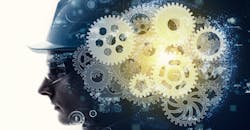What Jobs Will Artificial Intelligence Affect?
It’s impossible to ignore the fact that advances in artificial intelligence (AI) are changing how we do our current jobs. But what has captured even more interest is how the increasing capability of this technology will affect future jobs.
In trying to determine the specific effects on which jobs and which sectors, many studies have been undertaken but it’s hard to capture this information.
To add further research to this topic the Brookings Institution issued a report presenting a new method of analyzing this issue.
“By employing a novel technique developed by Stanford University Ph.D. candidate Michael Webb, the new report establishes job exposure levels by analyzing the overlap between AI-related patents and job descriptions,” the report said. “In this way, the research homes in on the impacts of AI specifically and does it by studying empirical statistical associations as opposed to expert forecasting.”
The technique Webb used was able to quantify the overlap between the text of AI patents and the text of job descriptions that can identify the kinds of tasks and occupations likely to be affected by particular AI capabilities.
“We find that Webb’s AI measures depict a very different range of impacts on the workforce than those from robotics and software. Where the robotics and software that dominate the automation field seem to mostly involve “routine or rule-based, tasks and thus lower-or-middle pay roles, AI’s distinctive capabilities suggest that high-wage occupations will be some of the most exposed,” the report noted.
Using patents is “useful here because they provide timely predictions of the commercial relevance of specific technological applications. Occupational descriptions are also useful because they provide detailed insight into economic activities at the scale of the whole economy."
Findings
- AI could affect work in virtually every occupational group.
- Better-paid, white-collar occupations may be the most exposed to AI, as well as some manufacturing and agriculture positions.
- Business, finance, and tech industries will be more exposed, as will natural resource and production industries.
- AI looks most destined to affect men, prime-age workers, and white and Asian-American workers.
- Bigger, higher-tech metro areas and communities heavily involved in manufacturing are likely to experience the most AI-related disruption
Based on these conclusions the report says that “we have a lot to learn about AI, and that these are extremely early days in our inquiries. What’s coming may not resemble what we have experienced or expect to experience.
“Society should get ready for a very different pattern of an impact than those that accompanied the broad adoption of robotics and software. While the last waves of automation led to increases of inequity and wage polarization, it’s not clear that AI will have the same effects.”
AI’s Effect on Jobs Might Not be What You Think originally appeared on IndustryWeek, an Endeavor Business Media partner site.
About the Author

Adrienne Selko
Senior Editor - MH&L, IW, & EHS Today
Adrienne Selko has written about many topics over the 17 years she has been with Endeavor Business Media and currently focuses on workforce development strategies. Previously Adrienne was in corporate communications at a medical manufacturing company as well as a large regional bank.
She is the author of Do I Have to Wear Garlic Around My Neck? which made the Cleveland Plain Dealer's best sellers list. She is a senior editor at Material Handling & Logistics, EHS Today, and IndustryWeek.
Editorial Mission Statement:
Manufacturing is the enviable position of creating products, processes, and policies that solve the world’s problems. When the industry stepped up to manufacture what was necessary to combat the pandemic, it revealed its true nature. My goal is to showcase the sector’s ability to address a broad range of workforce issues including technology, training, diversity & inclusion, with a goal of enticing future generations to join this amazing sector.
Why I Find Manufacturing Interesting:
On my first day working for a company that made medical equipment such as MRIs, I toured the plant floor. On every wall was a photo of a person, mostly children. I asked my supervisor why this was the case and he said that the work we do at this company has saved these people’s lives. “We never forget how important our work is and everyone’s contribution to that.” From that moment on I was hooked on manufacturing.
I have talked with many people in this field who have transformed their own career development to assist others. For example, companies are hiring those with disabilities, those previously incarcerated, and other talent pools that have been underutilized. I have talked with leaders who have brought out the best in their workforce, as well as employees doing their best work while doing good for the world.
